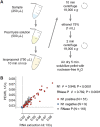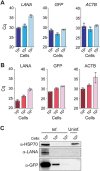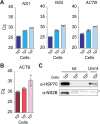A Fast and Accessible Method for the Isolation of RNA, DNA, and Protein To Facilitate the Detection of SARS-CoV-2
- PMID: 33293367
- PMCID: PMC8092744
- DOI: 10.1128/JCM.02403-20
A Fast and Accessible Method for the Isolation of RNA, DNA, and Protein To Facilitate the Detection of SARS-CoV-2
Abstract
Management of the coronavirus disease 2019 (COVID-19) pandemic requires widespread testing for severe acute respiratory syndrome coronavirus 2 (SARS-CoV-2). A main limitation for widespread SARS-CoV-2 testing is the global shortage of essential supplies, among them RNA extraction kits. The need for commercial RNA extraction kits places a bottleneck on tests that detect SARS-CoV-2 genetic material, including PCR-based reference tests. Here, we propose an alternative method we call PEARL (
Keywords: DNA and protein; SARS-CoV-2; field deployable; rapid isolation of RNA; virus detection.
Copyright © 2021 Ponce-Rojas et al.
Figures



Similar articles
-
A simple method for SARS-CoV-2 detection by rRT-PCR without the use of a commercial RNA extraction kit.J Virol Methods. 2020 Nov;285:113960. doi: 10.1016/j.jviromet.2020.113960. Epub 2020 Aug 22. J Virol Methods. 2020. PMID: 32835738 Free PMC article.
-
Use of a simplified sample processing step without RNA extraction for direct SARS-CoV-2 RT-PCR detection.J Clin Virol. 2020 Nov;132:104587. doi: 10.1016/j.jcv.2020.104587. Epub 2020 Aug 11. J Clin Virol. 2020. PMID: 32898817 Free PMC article.
-
SARS-CoV-2 RNA Extraction Using Magnetic Beads for Rapid Large-Scale Testing by RT-qPCR and RT-LAMP.Viruses. 2020 Aug 7;12(8):863. doi: 10.3390/v12080863. Viruses. 2020. PMID: 32784757 Free PMC article.
-
Understanding, Verifying, and Implementing Emergency Use Authorization Molecular Diagnostics for the Detection of SARS-CoV-2 RNA.J Clin Microbiol. 2020 Jul 23;58(8):e00796-20. doi: 10.1128/JCM.00796-20. Print 2020 Jul 23. J Clin Microbiol. 2020. PMID: 32381642 Free PMC article. Review.
-
Detection of COVID-19: A review of the current literature and future perspectives.Biosens Bioelectron. 2020 Oct 15;166:112455. doi: 10.1016/j.bios.2020.112455. Epub 2020 Jul 21. Biosens Bioelectron. 2020. PMID: 32739797 Free PMC article. Review.
Cited by
-
Open-source RNA extraction and RT-qPCR methods for SARS-CoV-2 detection.PLoS One. 2021 Feb 3;16(2):e0246647. doi: 10.1371/journal.pone.0246647. eCollection 2021. PLoS One. 2021. PMID: 33534838 Free PMC article.
-
Taking a step back from testing: Preanalytical considerations in molecular infectious disease diagnostics.Clin Biochem. 2023 May;115:22-32. doi: 10.1016/j.clinbiochem.2022.12.003. Epub 2022 Dec 8. Clin Biochem. 2023. PMID: 36495954 Free PMC article. Review.
-
CRISPR-based systems for sensitive and rapid on-site COVID-19 diagnostics.Trends Biotechnol. 2022 Nov;40(11):1346-1360. doi: 10.1016/j.tibtech.2022.06.002. Epub 2022 Jun 8. Trends Biotechnol. 2022. PMID: 35871983 Free PMC article. Review.
-
An updated review of SARS-CoV-2 detection methods in the context of a novel coronavirus pandemic.Bioeng Transl Med. 2022 Jun 22;8(1):e10356. doi: 10.1002/btm2.10356. Online ahead of print. Bioeng Transl Med. 2022. PMID: 35942232 Free PMC article. Review.
-
Recent progress on rapid SARS-CoV-2/COVID-19 detection by CRISPR-Cas13-based platforms.Drug Discov Today. 2021 Aug;26(8):2025-2035. doi: 10.1016/j.drudis.2021.06.005. Epub 2021 Jun 18. Drug Discov Today. 2021. PMID: 34147688 Free PMC article. Review.
References
-
- CDC. 2019. Novel coronavirus (2019-nCoV) real-time RT-PCR diagnostic panel. CDC, Atlanta, GA. https://www.fda.gov/media/134922/download. - PMC - PubMed
-
- Vogels CBF, Brito AF, Wyllie AL, Fauver JR, Ott IM, Kalinich CC, Petrone ME, Casanovas-Massana A, Muenker MC, Moore AJ, Klein J, Lu P, Lu-Culligan A, Jiang X, Kim DJ, Kudo E, Mao T, Moriyama M, Oh JE, Park A, Silva J, Song E, Takahashi T, Taura M, Tokuyama M, Venkataraman A, Weizman O-E, Wong P, Yang Y, Cheemarla NR, White EB, Lapidus S, Earnest R, Geng B, Vijayakumar P, Odio C, Fournier J, Bermejo S, Farhadian S, Cruz CSD, Iwasaki A, Ko AI, Landry ML, Foxman EF, Grubaugh ND. 2020. Analytical sensitivity and efficiency comparisons of SARS-CoV-2 RT–qPCR primer–probe sets. Nat Microbiol 5:1299–1305. doi:10.1038/s41564-020-0761-6. - DOI - PMC - PubMed
MeSH terms
Substances
LinkOut - more resources
Full Text Sources
Other Literature Sources
Medical
Miscellaneous

